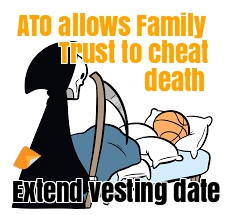Extend the vesting date of my family trust?
Most Australian trusts, at some point, must vest. The trust must end after 80 years. This is based on ancient English law. The government does not want a trust to go on forever. This is because it may end up that no one is looking after the assets in the trust. This is called the rule against perpetuities. The rule against perpetuities prevents a Trust from existing indefinitely.
All States have the Rule against Perpetuities – it ends all Australian trusts
Therefore, in all States, after 80 years your trust must ‘vest’. The trust must end. (South Australia is exempt from the law against perpetuities.) See for example Perpetuities Act 1984 (NSW). The 80-year’ perpetuity rule’ applies to:
- 3-Generation Testamentary Trusts (but the 80 years only starts at your death)
- Superannuation Proceeds Trusts (this reduces the 32% payable on your super at death)
- Superannuation Testamentary Trusts (stops 32% tax at death)
- Unit Trust
- Family Trust
- Bare Trusts
- Acknowledgement of Trust Deed – ‘AFTER the Trustee buys’
- Declaration of Trust BEFORE you buy – ‘secretly buy’
The vesting date is the date defined in the trust deed. This is the date when the trust comes to an end. The trustee winds up the trust on the vesting date. This is by distributing all of the trust assets to the beneficiaries. Whether the trustee does this or not the trust still ‘vests’. It comes to an end.
Self-managed superannuation funds have no perpetuity period. SMSF can live forever
An SMSF is a trust. So you would expect it to die after 80 years like all other trusts. However, the SMSF is a statutory trust. While it continues to have living members then it keeps on going – forever. Your SMSF can be handed down from generation to generation. The SMSF trust deed does need regular updates.
What is the ‘rule against perpetuities’?
The rule against perpetuities, also known as the rule against remoteness of vesting, sets a limit on how long future interests in property can be delayed before they must become certain or “vest.” This rule ensures that property interests can’t be held in limbo indefinitely.
In South Australia, this rule has been completely abolished. However, in other states and territories, it has been either modified or upheld with certain conditions.
Under common law, a future interest is considered invalid if there’s any chance it might not vest within the defined perpetuity period. But under statutory rules, the interest is only void if it actually does vest outside this period.
If a future interest is deemed void, whether, under common law or statutory rules, the ownership of the trust property goes back to the person who established the trust (the settlor) or their representatives. This process is known as a resulting trust.
Legislation and common law to stop Australian trusts from going on forever
The common law rule against perpetuities has been abolished in South Australia (section 61, Law of Property Act 1936 (SA), and modified by legislation in the other States and Territories.
- New South Wales: section 8 Perpetuities Act 1984 (NSW)
- Victoria: section 6 Perpetuities and Accumulations Act (Vic)
- Queensland: section 210, Property Law Act 1974 (Qld)
- South Australia: abolished, section 61, Law of Property Act 1936 (SA)
- Western Australia: section 103, Property Law Act 1969 (WA)
- Tasmania: section 9, Perpetuities and Accumulations Act 1992 (Tas)
- Northern Territory: section 190, Law of Property Act 2000 (NT)
- Australian Capital Territory: section 9, Perpetuities and Accumulations Act 1985 (ACT)
What happens when my trust ‘vests’. Does the death of a trust trigger taxes and problems?
In Australia, most states adhere to a statutory perpetuity period of 80 years, except for South Australia, which stands out as the exception. South Australia has taken a bold step by effectively doing away with the rule against perpetuities, allowing trusts in the state to operate beyond the traditional 80-year limit.
Under the usual setup in the other states, trusts must vest and terminate after 80 years, potentially triggering capital gains tax and stamp duty implications, especially if the trust holds assets subject to these taxes or has carried forward losses.
Upon vesting, the trust’s assets are distributed to beneficiaries as outlined in the trust deed. However, this also marks the end of any available carry-forward losses.
In contrast, South Australia’s legislation removes the constraints of the perpetuity rule. Trusts in SA can continue beyond the 80-year mark without facing the risk of invalidity due to perpetuity breaches. This flexibility has sparked significant interest, leading to a rush to establish trusts in South Australia or to amend existing trusts to fall under South Australian law. For ethical reasons, Legal Consolidated refuses to advise on this.
What happens to a trust when it vests and ends?
This means all the assets are deemed to have come out of your trust. This triggers:

- Capital Gains Tax
- Transfer (Stamp) Duty
- ownership issues
- asset protection
- loss of licenses
- land tax
- family law disputes
Before the start of CGT in 1985 many trusts often had a vesting date of less than 80 years. A vesting date of 21 years was not uncommon. Until recently the ATO took the view that you could not amend your trust deed to extend the vesting date to the maximum of 80 years.
The ATO has changed its mind – you can now postpone the vesting date
Taxation Ruling TR 2018/6, issued on 15 August 2018, finalises the Commissioner’s views on the income tax consequences of a trust vesting. These views are the same as those contained in the draft (TR 2017/D10), although the final ruling includes some fine-tuning.
A trust’s “vesting” or “termination” date is the day on which the beneficiaries’ interests in the property of the trust become “vested in interest and possession”. The trust deed should specify the vesting date and the consequences of that date being reached (eg that the trust property will be held from that date for the takers on vesting in equal shares absolutely). The ATO notes that vesting does not, of itself, ordinarily, cause the trust to come to an end or cause a new trust to arise. If the trustee continues to hold property for the takers on vesting, the property will be held on the same trust (although the nature of the trust relationship will change).
The ATO now believes that if you have a trust with a vesting date of less than 80 years then:
- provided you do it before the vesting date, you may extend the vesting date. But the maximum period is still 80 years (except in South Australia).
- if the vesting date has passed, you are too late. The trust has already been vested. The trust has ended. Extending the trust is no longer possible. Even all the beneficiaries coming together cannot change this.
- you need a Deed of Variation (or a Court order) to extend the vesting date to 80 years. This can’t be implied. The vesting date cannot be extended by implication – such as the trustee and beneficiaries acting in a certain way.
The ATO can change its mind again. Update the vesting date while you still legally can.
TR 2018/16 – ATO allows trust vesting dates to be extended:
- before vesting, it may be possible to extend the vesting date (by applying to a court or by the trustee exercising the power to nominate a new vesting date). A proposed alteration by a trustee without court intervention is subject to any specific requirements in the trust deed about how and when any alteration to the vesting date can occur;
- it is too late to change the vesting date once it has passed and the ATO says it is unlikely that a court would agree to do so due to the interests in the trust property becoming fixed at law; and
- continuing to administer the trust in a way that is inconsistent with the vesting terms can have significant tax consequences (eg potentially CGT event E1).

CGT when you end your trust
TR 2018/6 considers whether various CGT events may occur on vesting or post-vesting, noting that the terms of the trust deed are particularly relevant. The ATO says that:
CGT event E1
(creation of a new trust) “need not happen merely because a trust has vested”. This is because vesting does not, of itself, ordinarily, cause a trust to come to an end and its property to settle on the terms of a new trust. However, CGT event E1 may occur if the parties to a trust relationship subsequently act in a manner that results in a new trust being created by declaration or settlement;
CGT event E5
(beneficiary becoming entitled) may occur if the takers on vesting become entitled as against the trustee to CGT assets of the trust; and
CGT event E7
(disposal to a beneficiary to end a capital interest) may happen on actual distribution of CGT assets to beneficiaries, but will not occur to the extent that the beneficiaries are already absolutely entitled to the CGT assets as against the trustee.
Taxation of trust net income after the vesting date
The ruling notes that, in the income year of vesting, different beneficiaries may be presently entitled to trust income derived before and after the vesting date. For example, the trustee of a discretionary trust may, before vesting, exercise discretion to appoint pre-vesting income among those entitled to benefit under the trust. By contrast, the takers on vesting are presently entitled to post-vesting income (usually in proportion to their vested interests in the trust property). In this situation, the ATO accepts a “fair and reasonable” allocation of trust income into pre- and post-vesting trust income.
TR 2018/6 also provides that for trust vesting:
- in the income years after vesting, all of the trust income flows to the takers on vesting according to their entitlements, so the trustee will not be assessed on any net income; and
- a post-vesting payment or other purported distribution by the trustee is in breach of trust and void if it is inconsistent with the vested beneficiaries’ fixed interests, and the deemed present entitlement rules in sections 101 and 95A(1) ITAA 1936 don’t apply.
The ruling includes 6 examples, covering effective and ineffective extensions of the vesting date, the consequences of ignoring the vesting date and the entitlements of beneficiaries. The following example (Example 4 of TR 2018/6) involves the purported extension of the vesting date after a discretionary trust has vested.
If a deed of extension is ineffective in changing the trust’s vesting date, all of the takers on vesting agree that the trust assets should continue to be held on a new trust on the same terms as the original trust, and this was effective to create a new trust over the assets by declaration or settlement, CGT event E1 happens for the trust assets.
Is it too late to extend your trust to 80 years?
It may be argued that the trust does not come to an end. However, Legal Consolidated does not believe that is the case. On the vesting date, we believe that a new trust is created. The ATO Ruling has no clear view. The ATO states that the underlying trust relationship continues. However, the nature of the trust has so fundamentally changed that it is in a new trust – triggering taxes such as stamp duty and CGT.


